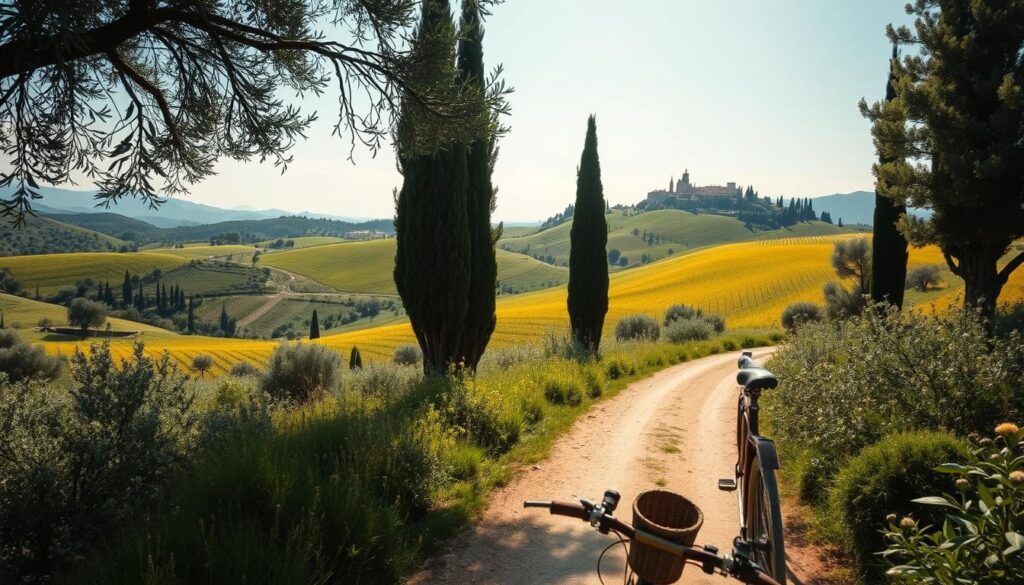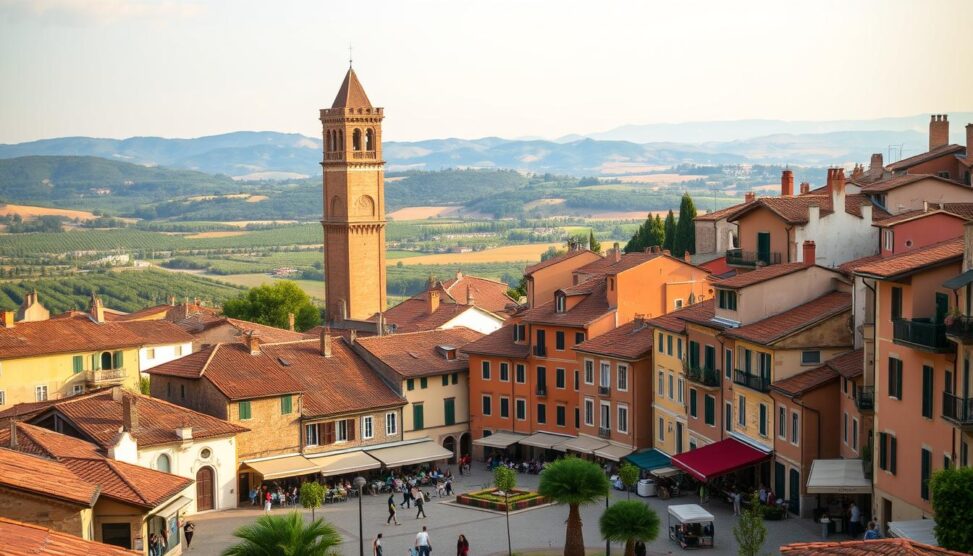Picture yourself on cobblestone streets of an Italian village. The aroma of fresh bread and espresso fills the air. This is regional Italian tourism—an authentic experience that immerses you in Italy’s heart and soul.
Italy blends ancient history with modern life seamlessly. Each region offers its own unique charm and character. Venture beyond Rome, Florence, and Venice to uncover hidden gems waiting for exploration.
Savor rich flavors of regional cuisine, made with local ingredients. Wander through picturesque villages where time seems to stand still. Friendly locals welcome you with open arms, sharing their authentic culture and lifestyle.
Regional Italian tourism caters to all interests. Hike in the breathtaking Dolomites or relax on Puglia’s pristine beaches. Choose from countless Italy vacation spots to create your perfect itinerary.
Prepare to be captivated by Italy’s warm people and beautiful landscapes. The country’s timeless allure will enchant you. Your unforgettable Italian travel experience awaits!
Introduction to Regional Italian Tourism
Italy’s charm extends beyond Rome, Venice, and Florence. Regional exploration unveils cultural treasures and stunning landscapes. Visitors can discover authentic experiences in lesser-known areas of the country.
Cinque Terre’s picturesque villages are a UNESCO World Heritage site. The Ligurian and Adriatic coasts boast vibrant towns. These regions offer diverse attractions for curious travelers.
Tuscany, Umbria, and Piedmont blend natural beauty with rich heritage. Ancient towns in these areas have thrived for centuries. The Republic of Venice’s 1,100-year history shaped regional art and architecture.
“Italy is a dream that keeps returning for the rest of your life.” – Anna Akhmatova
Italy’s islands, like Sicily and Sardinia, have unique customs and cuisines. Visitors can experience local life and hospitality. These hidden gems offer adventures off the beaten path.
More tourists now opt for regional exploration over major cities. This shift allows for immersive, personalized experiences. Travelers can engage with communities and savor regional specialties.
Exploring Italy’s Rich Cultural Heritage
Italy boasts 58 UNESCO World Heritage Sites, showcasing its rich history and artistic legacy. The ancient ruins of Pompeii attract 2.5 million visitors yearly. Florence’s Uffizi Gallery houses Renaissance masterpieces, highlighting Italy’s unparalleled cultural heritage.
Rome, the eternal city, welcomes 7 million international tourists annually. Visitors flock to iconic landmarks like the Colosseum and Vatican City. The Sistine Chapel represents Renaissance art’s pinnacle, while St. Peter’s Basilica attracts 6 million visitors yearly.
Italy’s lesser-known regions are equally rich in art and history. Tuscany’s villages offer immersive cultural experiences. Umbria’s medieval towns transport visitors back in time.
Canale di Tenno has preserved its original layout since 1211. This village showcases Italy’s commitment to maintaining its historical heritage.
“Italy’s cultural heritage is a testament to the creativity and ingenuity of its people throughout history, and it continues to inspire and captivate visitors from all over the world.”
Italy’s cultural tourism goes beyond historical sites. Numerous festivals celebrate its artistic heritage. The Venice Biennale attracts artists and art enthusiasts globally.
Exhibitions featuring Roberto Matta and Henri Matisse highlight Italy’s role in modern art. These events showcase Italy’s ongoing influence in the art world.
About 60% of tourists visit Italy for its art and culture. This makes cultural tourism vital to Italy’s economy. The country prepares for major events like the 2025 Jubilee.
The Jubilee is expected to attract millions of additional visitors. Italy’s cultural heritage remains a cornerstone of its appeal as a top travel destination.
Culinary Adventures in Italy
Discover Italy’s food tourism and its diverse regional cuisines. Italian food is a vital part of the country’s heritage. Each region offers unique flavors to savor.
Explore Italian wine regions like Tuscany, Piedmont, and Veneto. Learn about wine history while tasting premium vintages. The Gourmet Tuscany tour offers great wine experiences with savings.
Join cooking classes led by local chefs to learn authentic Italian dishes. Use fresh, local ingredients and traditional methods. Chef Stefano’s classes focus on techniques for creating personalized dishes.
These hands-on experiences provide insight into Italian culture and cuisine. Participants report high satisfaction rates and cultural immersion through cooking.
“The cooking sessions were incredible. We prepared fresh pasta and local specialties using seasonal ingredients. It wasn’t just about the recipes; it was a true cultural immersion.”
Try Italian street food and gourmet dinners on food tours. The Charming Sicily Food & Wine Tour is highly rated by travelers.
Attend culinary festivals to sample regional specialties and watch cooking demos. These events offer a festive atmosphere for food lovers.
Italy’s food tourism suits both foodies and curious travelers. Tours last 8-10 days and cater to various age groups. Book your trip to experience Italy’s flavors firsthand.
The Natural Beauty of Italy
Italy’s landscapes offer stunning beauty and diverse outdoor adventures. From Tuscany’s hills to the Dolomites and Northern Italy’s lakes, the country captivates nature-loving visitors. Rural tourism thrives in these picturesque settings.

The Dolomites, a UNESCO World Heritage site, showcase Italy’s natural splendor. These mountains cover 77,865 acres, with Marmolada peak reaching 3,343 meters. Hiking, skiing, and cycling attract outdoor enthusiasts to this region.
Sicily, Italy’s largest island, boasts varied landscapes. The Aeolian Islands offer thermal resorts and breathtaking scenery. Mount Etna, Europe’s highest active volcano, draws adventure seekers to its slopes.
“The rolling hills of Tuscany encompass over 170,000 hectares of vineyards, showcasing the region’s agricultural richness and scenic beauty.”
Northern Italy’s stunning lakes include Como, Garda, and Maggiore. These popular destinations offer outdoor activities and relaxation. Lake Como spans 56 square kilometers, shaped like an inverted Y.
Picturesque towns and villages surround these natural wonders. They add charm to the already beautiful landscape.
Italy’s national parks, like those in Abruzzo, protect diverse wildlife. Bears and wolves roam these areas. The country’s commitment to preserving nature shines through these protected spaces.
About 60% of tourists in Italy enjoy nature-related activities. The Amalfi Coast and Dolomites are especially popular among these visitors.
Millions visit Italy annually for outdoor experiences. From Castelluccio’s fiorita to Capri’s Blue Grotto, Italy’s beauty inspires global travelers.
Popular Regions to Visit
Italy boasts many unique regional tourism destinations. Each area offers a distinct mix of culture, history, and natural beauty. From Tuscany’s hills to the Amalfi Coast’s villages, Italian attractions abound.
Tuscany attracts over 10 million visitors yearly. Its Renaissance history and culinary delights make it a top choice. Wine enthusiasts and art lovers flock to this picturesque region.
The Amalfi Coast is perfect for stunning scenery and luxurious resorts. Colorful villages perch on cliffs along this iconic coastline. Its beauty has inspired artists and celebrities alike.
“Italy is a dream that keeps returning for the rest of your life.” – Anna Akhmatova
Sicily, the Mediterranean’s largest island, offers a unique Italian experience. It blends history, culture, and natural beauty seamlessly. Ancient Greek temples and pristine beaches attract nearly 2 million visitors annually.
The Italian Lakes region combines elegance with outdoor adventure. Lake Como and Lake Garda are known for stunning scenery. These areas attract affluent tourists and celebrities worldwide.
Italy’s regional destinations offer unparalleled experiences. From Puglia’s hidden gems to Rome’s iconic sites, there’s something for everyone. This enchanting country invites travelers to explore its diverse regions.
Adventure Activities in Italy
Italy offers endless outdoor adventures for thrill-seekers and nature lovers. From the majestic Alps to stunning coastlines, there’s something for everyone. Explore a wide range of sports and recreation activities across the country.
The Italian Alps and Dolomites are perfect for winter sports enthusiasts. Ski and snowboard down pristine slopes in these UNESCO World Heritage Sites. The Dolomites also boast scenic hiking trails for summer adventures.
Mont Blanc, Europe’s highest peak, challenges hikers with a 99-mile circuit. Gran Paradiso National Park offers Italy’s only peak above 13,000 feet. The Alpe Adria trail system spans 470 miles, connecting the Alps to the Adriatic Sea.
“The best view comes after the hardest climb.” – Unknown
Italy’s coastline is a water sports paradise. Sail crystal-clear waters, windsurf along shores, or dive into vibrant marine life. Rivers and lakes provide kayaking, canoeing, and rafting opportunities.
Cycling routes wind through picturesque countryside and coastal areas. The Roman Brescia Archaeological Park offers a taste of history and adventure. Hike the Path of the Gods for breathtaking Amalfi Coast views.
Explore Monteriggioni, known as the “Gateway to the Middle Ages.” Indulge in local culinary delights like Neapolitan pizza and buffalo mozzarella. Sip world-renowned Chianti wines to complete your Italian adventure.
Tips for Traveling in Italy
Planning an Italian vacation? Research the regions you’ll visit. Choose the best time based on your preferences and budget. Book accommodations and transportation early for better rates.
Learn basic Italian phrases to communicate with locals. Be aware of dress codes in religious sites. Understand local dining etiquette. Prepare for differences in electrical outlets and currency.
Always validate your public transport tickets to avoid fines. Use public fountains for free water. They’re sustainable and save money. Be careful crossing streets in historic centers.
“Booking tickets for guided tours of popular attractions in advance is recommended to bypass long queues and ensure availability.”
Pack light for easier navigation on cobblestone streets. Visit major attractions early or late to avoid crowds. Explore nature trails for outdoor activities.
Download maps and directions before your trip. Internet may not be reliable everywhere. Embrace local culture and cuisine. Create unforgettable memories in this captivating country.
Sustainable Tourism in Italy
Italy is making great efforts to promote eco-friendly travel. Green initiatives aim to preserve the country’s natural beauty and cultural heritage. Many accommodations now use renewable energy, minimize waste, and source local products.
Travelers can support responsible tourism by choosing eco-friendly lodgings. Being mindful of their impact on local communities is crucial. Using public transport or cycling helps reduce one’s carbon footprint while exploring Italy.

Popular destinations like Cinque Terre have introduced measures to manage visitor numbers. These efforts aim to protect fragile environments from overcrowding. They also address the strain on local resources and infrastructure.
Venice is tackling environmental issues caused by large cruise ships in its lagoon. These actions help preserve the city’s delicate ecosystem for future generations.
“Sustainable tourism is not just about preserving the environment; it’s about supporting local communities and their traditions.” – Maria Rossi, Italian sustainable tourism expert
Sustainable tourism helps preserve Italy’s beauty and cultural richness. Agriturismo stays in Tuscany and Umbria offer meals made with on-site ingredients. This approach promotes local agricultural practices and reduces food miles.
Vineyards in Tuscany and olive groves in Puglia focus on organic farming. These methods protect the environment while producing high-quality products. Visitors can enjoy these sustainable offerings directly from the source.
Local markets offer another way to support eco-friendly travel in Italy. Campo de’ Fiori in Rome and Ballarò Market in Palermo showcase sustainable food culture. Shopping at these markets helps support local producers and reduces environmental impact.
Unique Experiences Beyond the Tourist Path
Italy’s hidden spots offer authentic experiences for adventurous travelers. These lesser-known places reveal the country’s rich cultural heritage. Exploring them provides insight into diverse regional traditions.
Visit smaller towns to immerse yourself in local life. The Maremma region in Tuscany attracts fewer visitors than popular areas. It boasts stunning natural beauty and fascinating history.
Bassano del Grappa and Castelli Romani villages offer unique experiences away from crowds. These places allow you to enjoy Italy without the tourist rush.
Local festivals provide a deeper understanding of Italian culture. The Alba truffle festival attracts over 50,000 visitors annually. Martina Franca’s summer opera festival draws music lovers to this charming Puglian town.
“Nearly 45% of tourists express a desire for experiences that are more local and authentic, indicating a demand for off-the-beaten-path recommendations.”
Food lovers can explore regional specialties through cooking classes or food tours. Modena, home to Osteria Francescana, has gained culinary fame recently. Camogli, a seaside village, attracts visitors with its delicious Ligurian seafood.
Venture beyond typical tourist spots to create unforgettable memories. Discover Italy’s hidden gems and diverse regions. Embrace off-the-beaten-path experiences to truly understand Italy’s captivating culture and beauty.
How to Plan Your Regional Italian Trip
Planning an Italian trip is thrilling but needs careful thought. Start by choosing your favorite regions and activities. Italy offers historical cities and stunning coastlines for every traveler.
Consider your trip length and desired destinations. Budget about €100 per day for food and activities. For a 10-day trip, plan three main stops with three nights each.
Book early, especially for peak seasons. Summer brings high prices and crowds. Spring and fall offer better deals. Consider travel insurance for unexpected events.
“Italy is a dream that keeps returning for the rest of your life.” – Anna Akhmatova
Gather necessary documents like passports and visas early. New passports can take months to process. Learn basic Italian phrases and local customs.
Take time to research and prepare. This helps create a personalized Italian adventure. Explore ancient ruins, savor Tuscan cuisine, or relax on Amalfi beaches.
Conclusion: Why Choose Regional Italian Tourism?
Regional Italian tourism offers a unique experience for travelers. It lets you discover Italy’s true essence beyond popular tourist spots. You’ll immerse yourself in authentic Italian experiences across diverse regions.
Italy’s regions showcase a rich tapestry of cultural heritage. From Tuscany’s rolling hills to the Amalfi Coast’s dramatic coastlines, natural beauty abounds. Vibrant local communities add to the charm of each area.
Engage with locals and join festivals to create meaningful connections. Support sustainable tourism to positively impact the communities you visit. Italy attracts about 60 million tourists yearly, ranking fourth in international tourism arrivals.
Italy boasts over 4,000 museums and 6,000 archaeological sites. It also has 85,000 historic churches and 40,000 historic palaces. These cultural treasures await your exploration.
Regional Italian travel offers many benefits. Savor authentic regional cuisines and discover hidden gems. Gain a deeper appreciation for Italy’s rich history, art, and traditions.
Italy caters to various travel preferences. Whether you seek relaxation, adventure, or cultural enrichment, you’ll find it here. The country’s tourism infrastructure is well-developed with diverse accommodations.
Choose regional Italian tourism to support local economies. Help preserve cultural heritage while creating cherished memories. Let Italy’s regional charm captivate your heart and soul.





Leave a Reply